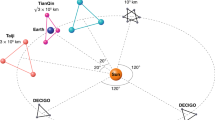Abstract
The paper describes the progress toward a space-borne gravitational wave observatory and its foreseeable science potential. In particular the paper describes the status of the LISA-like mission called eLISA, the reference mission for the Gravitational Universe theme adopted by ESA for its Large mission L3, and the status of its precursor LISA Pathfinder, due to launch in 2015.








Similar content being viewed by others
Notes
In addition to those effect, the signal would also carry the large frequency drift due to the secular change of the length of the arm. This signal is out of the measurement band of the instrument and is effectively suppressed by the data processing.
Forces in the following are always intended per unit mass. To stress this, we prefer to indicate forces by using the symbol g instead of the more obvious f like in force.
References
Vitale, S., et al.: Lisa and its in-flight test precursor on smart-2. Nucl. Phys. B (Proc. Suppl.) 110, 209 (2002)
Amaro Seoane, P., et al.: The Gravitational Universe arXiv:1305.5720 [astro-ph.CO], (2013)
http://sci.esa.int/ngo/49839-ngo-assessment-study-report-yellow-book/#
Seto, N., Kawamura, S., Nakamura, T.: Possibility of direct measurement of the acceleration of the universe using 0.1 hz band laser interferometer gravitational wave antenna in space. Phys. Rev. Lett. 87, 221103 (2001)
Crowder, J., Cornish, N.J.: Beyond lisa: exploring future gravitational wave missions. Phys. Rev. D 72, 083005 (2005)
Livas, J., et al.: SGO Mid: A LISA-like concept for the space-based gravitational-wave observatory (SGO) at a middle price-point, http://pcos.gsfc.nasa.gov/studies/rfi/GWRFI-0015-Livas
http://sci.esa.int/cosmic-vision/53259-esas-new-vision-to-study-the-invisible-universe/
Congedo, G., et al.: Space-borne gravitational-wave detectors as time-delayed differential dynamometers. Phys. Rev. D 88, 082003 (2013)
Anza, S., et al.: The ltp experiment on the lisa pathfinder mission. Class. Quantum Gravit. 22, S125–S138 (2005)
Amaro-Seoane, P., et al.: Low-frequency gravitational-wave science with elisa/ngo. Class. Quantum Gravit. 29, 124016 (2012). doi:10.1088/0264-9381/29/12/124016
Tinto, M., Dhurandhar, S.V.: Time-delay interferometry. Living Rev. Relat. 8, 4 (2005)
de Vine, G., et al.: Experimental demonstration of time-delay interferometry for the laser interferometer space antenna. Phys. Rev. Lett. 104, 211103 (2010)
Mitryk, S.J., Mueller, G., Sanjuan, J.: Hardware-based demonstration of time-delay interferometry and tdi-ranging with spacecraft motion effects. Phys. Rev. D 86, 122006 (2012)
Dolesi, R., et al.: Gravitational sensor for lisa and its technology demonstration mission. Class. Quantum Gravit. 20, S99S108 (2003)
Robertson, D.I., et al.: Construction and testing of the optical bench for lisa pathfinder. Class. Quantum Gravit. 30, 085006 (2013)
Audley, H., et al.: The lisa pathfinder interferometryhardware and system testing. Class. Quantum Gravit. 28, 094003 (2011)
Matticari, G., et al.: Cold gas micro propulsion prototype for very fine spacecraft attitude/position control. In: 42nd AIAA/ASME/SAE/ASEE Joint Propulsion Conference & Exhibit American Institute of Aeronautics and Astronautics (2006) doi:10.2514/6.2006-4872
Antonucci, F., et al.: Lisa pathfinder data analysis. Class. Quantum Gravit. 28, 094006 (2011). doi:10.1088/0264-9381/28/9/094006
Ferraioli, L., Hueller, M., Vitale, S.: Discrete derivative estimation in lisa pathfinder data reduction. Class. Quantum Gravit. 26, 094013 (2009). doi:10.1088/0264-9381/26/9/094013
Grynagier, A., Fichter, W., Vitale, S.: The lisa pathfinder drift mode: implementation solutions for a robust algorithm. Class. Quantum Gravit. 26, 094007 (2009). doi:10.1088/0264-9381/26/9/094007
The LTP data analysis tool (LTPDA) is downloadable at http://www.lisa.aei-hannover.de/ltpda/
Carbone, L., et al.: Achieving geodetic motion for lisa test masses: ground testing results. Phys. Rev. Lett. 91, 151101 (2003)
Cavalleri, A., et al.: A new torsion pendulum for testing the limits of free-fall for lisa test masses. Class. Quantum Gravit. 26, 094017 (2009)
Carbone, L., et al.: Thermal gradient-induced forces on geodesic reference masses for lisa. Phys. Rev. D 76, 102003 (2007)
Cavalleri, A., et al.: Increased brownian force noise from molecular impacts in a constrained volume. Phys. Rev. Lett. 103, 140601 (2009)
Antonucci, F., et al.: The interaction between stray electrostatic fields and a charged free-falling test mass. Phys. Rev. Lett. 108, 181101 (2012)
Antonucci, F., et al.: The lisa pathfinder mission. Class. Quantum Gravit. 29, 124014 (2012). doi:10.1088/0264-9381/29/12/124014
Acknowledgments
I thank Karsten Danzmann, Paul McNamara and Bill Weber for their critical reading of the manuscript.
Author information
Authors and Affiliations
Corresponding author
Additional information
Stefano Vitale for the eLISA consortium and the LISA Pathfinder team.
This article belongs to the Topical Collection: The First Century of General Relativity: GR20/Amaldi10.
Rights and permissions
About this article
Cite this article
Vitale, S. Space-borne gravitational wave observatories. Gen Relativ Gravit 46, 1730 (2014). https://doi.org/10.1007/s10714-014-1730-2
Received:
Accepted:
Published:
DOI: https://doi.org/10.1007/s10714-014-1730-2




